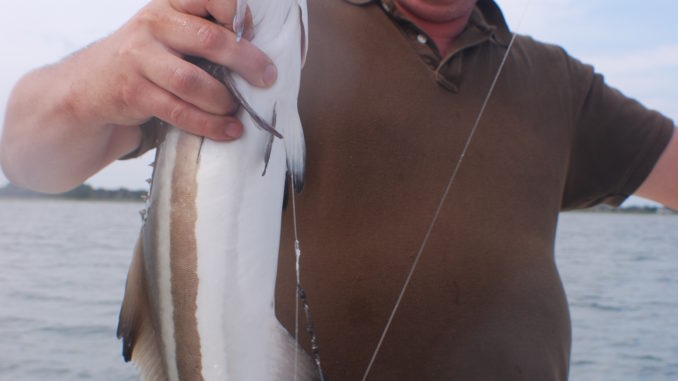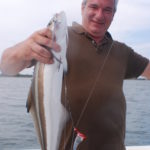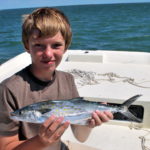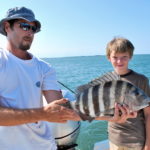
Ocracoke Island is out of the way, but it’s one of North Carolina’s best coastal fisheries, offering a summer smorgasborg for anglers.
On the highways that run south from Corolla, the village of Ocracoke is the end of the line on North Carolina’s Outer Banks. Other inlets are more-easily accessed; getting to Ocracoke is a test of patience or a relaxing ride, depending on how you view the 40-minute ferry trip from Hatteras or the 2-hour ferry trips from Swan Quarter or Cedar Island.
The reward is that the waters around the island abound with all kinds of fish, and the fishing pressure is next to nothing. Ocracoke Inlet holds Spanish mackerel flashing their metallic sides like eyes winking, bluefish rushing in from behind and below as if attracted to the light. Flounder fill Wallace Channel — on a good day you will want to move on to some surprising species after catching so many. Possibilities include big summer cobia, sheepshead to 12 pounds, black drum 15 pounds or better, and tide rips where the water enters or leaves Pamlico Sound.
Capt. Ryan O’Neal earned his charter captain’s license at age 18. He’s fished the waters around Ocracoke for years and comes from a long family tradition of fishing. He surveyed the waters one day last summer and weighed in on what they might hold.
“No wind today. The water’s flat and that tide is just now creeping in. Let’s get some Spanish,” he said, pointing his 24-foot Privateer, the “Tarheel” south from Silver Lake, the village harbor, toward Blair Channel, leaping from his seat once the skiff was on plane, deftly pulling trolling rods from their holders on the canopy.
O’Neal put rods along the stern, No. 0 Clark Spoons tied directly to 25-foot leaders of 25-pound fluorocarbon attached to No. 1 planers with a hundred feet of line out, except for one spoon behind a 4-ounce trolling sinker for a shallow trip. Trolled at 5 to 6 knots, the planer will get the spoons down 8 feet. The spoons, according to O’Neal, imitate silversides, small menhaden and finger mullet, some of their favorite foods.
From May into October, Spanish mackerel move in pods and larger schools along the edges of the inlet’s two main channels, Blair and Wallace, and also outside in the ocean. Available on occasion to surf anglers up and down the Outer Banks, they are also a favorite summertime target from piers. But for reliable consistency, nothing beats trolling for these sleek, silvery-blue speedsters with the large, golden spots and deeply forked tails.
Alan Sutton at Tradewinds Tackle in Ocracoke said Spanish begin their migration northward from Florida early in the year. Naturally, they are drawn to inlets for the concentration of forage fish found there. They are not available off the ends of piers in large numbers since the slopes of beaches are more or less even, schools are more dispersed than around inlets. Although Ocracoke Inlet’s two channels are large, they are well defined, and you can bet on finding Spanish somewhere along an edge. Evening sometimes results in a run, although mornings not only feel fresh, fish seem to thrive for a few hours or more after darkness.
“It can make a difference on what side of the channel’s edge you troll,” Sutton said.
Looking for birds to find a roving school may help, but mackerel do not always feed right at the surface. Ultimately, trolling is a search method when mackerel or blues are not immediately evident. But one factor above others is important
“See how clear the water is?” O’Neal asked, lining up to troll along the northern edge of Blair Channel. “The tide’s really comin’ in. Spanish are sight feeders. So I always look for action in the morning on a rising tide with clear water.”
It didn’t take long. A rod bent almost on cue, and an 18-inch mackerel was soon in the boat, a fish that proved to be about the average size. O’Neal’s party caught a dozen or so trolling the edges of Blair Channel and about as many blues from 1 to 3 pounds. Bluefish tend to move in smaller pods and are slightly deeper and behind schools of mackerel, as if they smell the scraps left behind from slaughters as the Spanish race on ahead in quick, frenzied, lightning formations. In fact, bluefish rely on scent to a much greater degree than mackerel.
“Some mornings, the Spanish run a pound or two, others they’ll be about 3 pounds,” O’Neal said. “The world record 13-pounder came from this inlet, and every summer we get Spanish over 5 pounds.”
Portsmouth Island beckoned about a half-mile to the south, a sand bank that defines the northern terminus of Cape Lookout National Seashore. Soon, O’Neal’s boat was almost in chatting distance from a couple walking the water’s edge; Wallace Channel cuts the sand close and scoops it out to depths of almost 30 feet. Through summer into early fall, flounder are not the only desirable fish lurking among its mysterious current variations and other bottom obstructions, but they are the bulk of the fish. Sheepshead, puppy drum, black drum, cobia and large red drum are just outside the inlet on occasion and are worthy summer targets. Cobia prowl nearer the ocean; sheepshead and black drum position towards the sound.
“With just the tide to carry us, no wind, we’ll move at about ½ to 1 knot, which is perfect; 1½ to 2 knots is too fast,” O’Neal said.
Speck rigs — red/white and chartreuse/white — with 1/0 hooks got fresh strips of squid on each flounder rod, medium-action, 6-foot spinning outfits loaded with 12-pound test. O’Neal also likes shiny strips of mackerel belly, Three-ounce bank sinkers attached to snap swivels carry the offerings to the bottom.
“Let out just enough line to stay at an angle and let drift,” O’Neal told the two members of his fishing party. “When you feel something like added weight, open the bail and let out line for a few seconds before you set the hook.”
The flounder that were hooked up averaged about 16 inches long, and the large number didn’t surprise O’Neal, who caught them steadily all day. A flounder fights with a unique, head-shaking persistence that feels like it might throw the hook at any instant, and sometimes they do get off, but in the middle of all the action with flounder, something a lot larger struck. This fish was no flounder, judging by the quick, steady runs, sudden turns, and smooth power.
“Cobia!” O’Neal shouted.
The brown stripe came into view. Less than the 33-inch legal minimum size, the cobia weighed more than 6 pounds. Drifting speck rigs for flounder, O’Neal’s clients often catch cobia 20 to 25 pounds, occasionally as large as 40.
“Last year, I boated one 69 pounds out on the ocean that hit a 4-ounce bucktail,” he said.
Sutton said a 3- or 4-ounce bucktail with an 8-inch plastic-worm trailer is standard fare for fishermen targeting cobia. Sight-fishing is often the preferred method with clear water and calm seas making it easier to see them. The object is to cast beyond the fish and retrieve the bucktail quickly and close to the fish to tease a strike.
DESTINATION INFORMATION
HOW TO GET THERE, WHEN TO GO — Ocracoke is a ferry ride from the mainland, either from Swan Quarter on US 264 or Cedar Island on US 70/NC 12. The fee ferry ride is about two hours. From the north, take NC 12 south to Hatteras and take the free ferry to the northern end of Ocracoke Island, then drive 16 miles to Ocracoke village. Once in Ocracoke, the public boat ramp is next to the ferry terminal. Best fishing is on rising tides in the morning, from June to early October.
TACKLE/TECHNIQUES — For Spanish mackerel and bluefish, No. 0 or 00 Clark Spoons tied to a leader of 25-pound fluorocarbon that’s attached to a No. 1 planer or 4-ounce trolling sinker, then to the running line. Trolling rods heavy enough to handle planers are required. For flounder and cobia—speck rigs in red/white or chartreuse/white are baited with strips of squid or mackerel belly. Medium-action spinning rods are the ticket. If sight-fishing for cobia, 3- to 4-ounce bucktails with 8-inch plastic-worm trailers are preferred on heavy spinning or casting rods. For sheepshead and black drum, 2-hook bottom rigs with 2-ounce bank sinkers and 1/0 hooks baited with sand fleas are fished on medium-power spinning tackle.
FISHING INFO/GUIDES — Capt. Ryan O’Neal, Ocracoke Sportfishing, 252-928-9966 or www.ocracokesportfishing.com; Tradewinds Tackle, 1094 Irwin Garrish Highway, 252-928-5491 or www.fishtradewinds.com. See also Guides & Charters in Classifieds.
ACCOMMODATIONS — Anchorage Inn & Marina Motel, 205 Irvin Garrish Highway, 252-928-3421; Blackbeard’s Lodge, 111 Back Rd., 252-928-3421; Edwards of Ocracoke, 216 Old Beach Rd., 800-254-1359; Silver Lake Motel, PO Box 1716, 252-928-6721; Harborside Motel, Silver Lake Rd., 252-928-3111; Bluff Shoal Motel, Silver Lake Rd., 252-928-4301; Pony Island Motel, 785 Irvin Garrish Highway, 800-928-4411; Ocracoke Island Vacation Rentals/Island Realty, 1075 Irvin Garrish Highway, 877-646-2822.
MAPS — Capt. Segull’s Nautical Charts, 888-473-4855 or www.captainsegullcharts.com; GMCO Chartbook of NC, 888-420-6277 or www.gmcomaps.com.






Be the first to comment